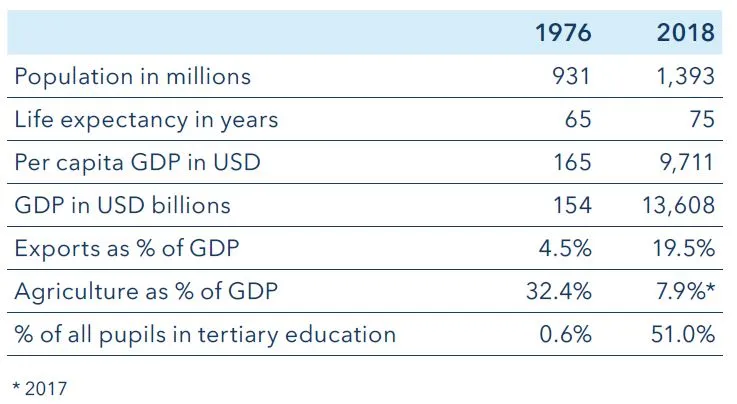Chinas Mission
China’s economic ascent since the death of Mao Zedong in 1976 is an unprecedented success story. In that year, China’s standard of living, as measured by per capita GDP, was below that of countries like Haiti, Niger, Somalia and Afghanistan. Today it outranks the Balkan nations and many countries in Latin America. Hunger has been banished, poverty reduced and life expectancy lengthened. While the West marvels at China’s progress, the Chinese themselves view it as a return to lost greatness. According to OECD estimates, 200 years ago China accounted for about a third of global GDP, significantly more than Europe (23%) and the USA (2%) combined. Today it is the world’s second largest economy, though per capita income is still nearer that of the emerging economies than the developed nations.
Meteoric development since the end of the Mao era

This article opens our quarterly publication Investment Views which focusses on China.
The other topics are:
Still demand for the workshop
Wanted: foreign capital
Technology to the fore
Commodity superpower
Limits to growth
Despite the success of China‘s reforms and the gradual opening-up of its economy, the country is now clearly becoming overstretched.
- A high saving rate and low consumption are encouraging borrowing and intensive investment.
- But returns on investment are falling, with an increased danger of misallocations.
- The influx of cheap migrant labour into the coastal cities had kept wage growth disproportionately low, despite productivity improvements. This reservoir of cheap labour is now exhausted and the influx is drying up.
- Higher wages and cheap competition from other countries are making Chinese products less competitive. Textile manufacture, for example, has migrated to Bangladesh and Vietnam and is now moving on to Ethiopia.
- China’s export dependence and trade surplus make it vulnerable to external influences. This vulnerability became evident during the financial crisis and has resurfaced under the impact of the current trade conflict.
- Economic progress has not been accompanied by an adequate improvement in the protection of intellectual property. The laws on patent and trademark protection have been beefed up, but they are not being properly enforced. This sours relations with China’s trading partners and prompts resistance to Chinese acquisitions of foreign companies.
- The focus on rapid growth has lifted millions of people out of poverty but has resulted in huge inequalities. The classless society now exists only on paper.
- The disparities are not just social but also geographical. Western and central regions cannot keep up with the enormous improvement in the standard of living along the coast. Per capita GDP in Gansu in the north-west is less than a third of that of Shanghai.
- Relentless growth has been achieved at the cost of damaging the environment, threatening citizens‘ health and ultimately imperilling social harmony.
- The negative consequences of the one-child policy are coming to the fore. China has an unusually disadvantageous age structure for an up-and-coming economy. (See “The problem with China’s saving rate” on page 12).
China‘s plan for the economic future
China‘s leaders are aware of these challenges and want to move away from the “workshop of the world“ model that has served the country so well in the past. No new growth targets will be set when the current five-year plan expires in 2020. Even so, economic growth will still be at the centre of government thinking. The government‘s legitimacy depends on continuously raising the population‘s standard of living.
Restructuring the economy and reducing dependence on exports is a mammoth task. But progress is being made. Personal consumption as a proportion of GDP has been rising since 2009 and now accounts for around two-thirds of the growth rate. The focus is shifting from wage restraint as a means of maintaining international competitiveness to measures designed to enhance purchasing power (see “Europa and Asia infected by China’s slowdown” on page 8). But increased consumption also means more imports. Exchange rate policy is therefore moving away from a cheap renminbi – a shift that facilitates the internationalisation of the Chinese currency.
This, however, poses challenges for the export industry. China wants to continue to be a major manufacturing nation. But that means reshaping its industrial base, for example by switching to less labour intensive products that have a higher added value. Moreover, the country that invented movable type printing 400 years before Europe will not just want to be a producer but will also aim to play a part in research and development. With their Confucian traditions, the Chinese have a vast hunger for knowledge. There is certainly no shortage of students. The Ministry of Education states that almost six million young adults are studying at university level while a further 2.7 million are in post-diploma education and another 400,000 are studying for a doctorate. Quantity is no guarantee of quality, of course. Innovation cannot be enforced. China scores well in the OECD’s Programme for International Student Assessment (PISA), but the education system still focuses on rote learning and regurgitation of facts in exams. To make the next generation more fit for the future, syllabuses now include courses in creative thinking. Other Asian countries like Japan and Korea have already moved in that direction. Research has shown that when a country devises and patents more inventions, protection for intellectual property tends to improve.
The shift from quantitative to qualitative growth is at the heart of the “Made in China 2025” strategy unveiled in 2015. China wants to shed its emerging market status and become a full-fledged industrialised nation. Future-looking industries like robotics and environmental technology are key elements in this strategy. In many new technologies, notably artificial intelligence, China is directly challenging the USA, whose corporations are leaders in these fields. The two countries‘ ambition to spearhead the technologies of the future is likely to be a tricky issue when negotiating a resolution of the current trade conflict.
In its quest for new competitive advantages, China has recognised the vital importance of direct and rapid links with its trading partners. Fast delivery is crucial for achieving maximum flexibility in reacting to customers’ needs. This is the motive behind the Belt and Road Initiative (BRI), a mammoth undertaking designed to bring Chinese suppliers logistically closer to their foreign customers via the northern land route and southern sea route. Here again China is harking back to historical precedents, which is why the project is also known as the new Silk Road. It takes six weeks to transport Chinese goods to Europe by sea. As part of the BRI, a direct freight rail service between China and Austria will be created alongside the already existing China-Duisburg connection. Rail transport cuts delivery time to two weeks. These infrastructure improvements are not only economically motivated but also serve strategic interests. The construction of the 135 kilometre Kra Canal in southern Thailand, for instance, would mean that ships no longer have to sail through the strategically sensitive Strait of Malacca. But these gigantic construction projects swallow up enormous sums of money. In the context of the Belt and Road Initiative China is carrying out numerous infrastructure projects in financially weak countries. This results in a huge increase in power and influence, pushing these countries into one-sided dependence on China. That is why the Belt and Road Initiative has become so controversial internationally.
Playing safe politically
Economic, ecological and social developments mean that China’s success model is reaching the end of its usefulness. China is now aiming even higher and hoping to regain lost glory. The romantic desire to relive China’s powerful past fits in well with hard-headed government self-interest. As long as large swathes of the population enjoy a rising standard of living, social inequalities will be accepted and the political status quo will remain unchallenged. A major weakening of the economy cannot be permitted. Even so, the restructuring of the economy inevitably involves short-term risks to growth.
President Xi Jinping is responding to these risks by strengthening his power base and revamping government policy. In March 2018 the National People’s Congress abolished the limit on the President’s term of office – a limit that was introduced after Mao’s death and had been respected ever since. Thus Xi is now President for life. However, this is the least important of the three offices of state that he holds. The presidency is primarily a ceremonial office – its political clout is limited. Much more powerful is the office of General Secretary of the Communist Party, which Xi also holds and which has never been time-limited. He is also Chairman of the Central Military Commission, giving him direct authority over China’s armed forces. This concentration of powers puts Xi on a par with Mao Zedong.
Xi pursues a two-pronged political course. Internationally he likes to appear as a champion of globalisation, as he did two years ago at the World Economic Forum in Davos. In his speech to world leaders he criticised nationalistic trends, especially President Trump’s America First policy. On the home front, however, Xi is an unapologetic advocate of a China First approach. He invokes Chinese identity and national values and talks of China’s “rightful place at the centre of the world“. Freedom of expression in the press and social media has been curtailed. Xi regards the Communist Party as the sole moral authority able to combat the erosion of values. A key ingredient in this process is the deployment of mass surveillance using new technologies like ultra-sophisticated CCTV, face recognition and artificial intelligence.
This concentration of power is unusual even for China. The leadership justifies it by referring to the need for stability while the economy is put on a new footing. The emphasis on Chinese ideology is also intended to ensure the unbroken supremacy of the Communist Party in case economic turbulence should raise questions about the Party’s position. Policies that stress national identity also create a counterweight to Western influences, which will undoubtedly grow as China opens up. This is an age-old fear of the Chinese, who have a saying that “If you open the window to let in fresh air, you’ll also let in the flies. “
Conclusion
The increasingly obvious limits to the previous growth model, combined with new ambitious objectives, mean that China stands on the threshold of major changes. The political leadership is alive to the challenges that the country faces and has already initiated various projects. The aim is to achieve more sustainable growth focused on higher quality. But that means abandoning the unsustainably high growth rates of the past. The improved standard of living generated by rapid growth helps explain why the power of the Communist Party has so far not been seriously questioned. The revamping of the economic model will pose increased risks in the short term. The leadership is therefore resorting to political measures to shore up its position. In this way it also hopes to counter the intrusion of foreign influences as the country opens up. Be that as it may, China needs the rest of the world just as much as the rest of the world needs China.
---
Author
Bernd Hartmann,
Chief Strategist VP Bank



Add the first comment